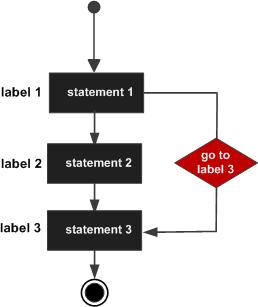
- Perl Basics
- Perl - Home
- Perl - Introduction
- Perl - Environment
- Perl - Syntax Overview
- Perl - Data Types
- Perl - Variables
- Perl - Scalars
- Perl - Arrays
- Perl - Hashes
- Perl - IF...ELSE
- Perl - Loops
- Perl - Operators
- Perl - Date & Time
- Perl - Subroutines
- Perl - References
- Perl - Formats
- Perl - File I/O
- Perl - Directories
- Perl - Error Handling
- Perl - Special Variables
- Perl - Coding Standard
- Perl - Regular Expressions
- Perl - Sending Email
- Perl Advanced
- Perl - Socket Programming
- Perl - Object Oriented
- Perl - Database Access
- Perl - CGI Programming
- Perl - Packages & Modules
- Perl - Process Management
- Perl - Embedded Documentation
- Perl - Functions References
- Perl Useful Resources
- Perl - Questions and Answers
- Perl - Quick Guide
- Perl - Useful Resources
- Perl - Discussion
Perl goto Statement
Perl does support a goto statement. There are three forms: goto LABEL, goto EXPR, and goto &NAME.
| Sr.No. | goto type |
|---|---|
| 1 | goto LABEL The goto LABEL form jumps to the statement labeled with LABEL and resumes execution from there. |
| 2 | goto EXPR The goto EXPR form is just a generalization of goto LABEL. It expects the expression to return a label name and then jumps to that labeled statement. |
| 3 | goto &NAME It substitutes a call to the named subroutine for the currently running subroutine. |
Syntax
The syntax for a goto statements is as follows −
goto LABEL or goto EXPR or goto &NAME
Flow Diagram

Example
The following program shows the most frequently used form of goto statement −
#/usr/local/bin/perl
$a = 10;
LOOP:do {
if( $a == 15) {
# skip the iteration.
$a = $a + 1;
# use goto LABEL form
goto LOOP;
}
print "Value of a = $a\n";
$a = $a + 1;
} while( $a < 20 );
When the above code is executed, it produces the following result −
Value of a = 10 Value of a = 11 Value of a = 12 Value of a = 13 Value of a = 14 Value of a = 16 Value of a = 17 Value of a = 18 Value of a = 19
Following example shows the usage of goto EXPR form. Here we are using two strings and then concatenating them using string concatenation operator (.). Finally, its forming a label and goto is being used to jump to the label −
#/usr/local/bin/perl
$a = 10;
$str1 = "LO";
$str2 = "OP";
LOOP:do {
if( $a == 15) {
# skip the iteration.
$a = $a + 1;
# use goto EXPR form
goto $str1.$str2;
}
print "Value of a = $a\n";
$a = $a + 1;
} while( $a < 20 );
When the above code is executed, it produces the following result −
Value of a = 10 Value of a = 11 Value of a = 12 Value of a = 13 Value of a = 14 Value of a = 16 Value of a = 17 Value of a = 18 Value of a = 19